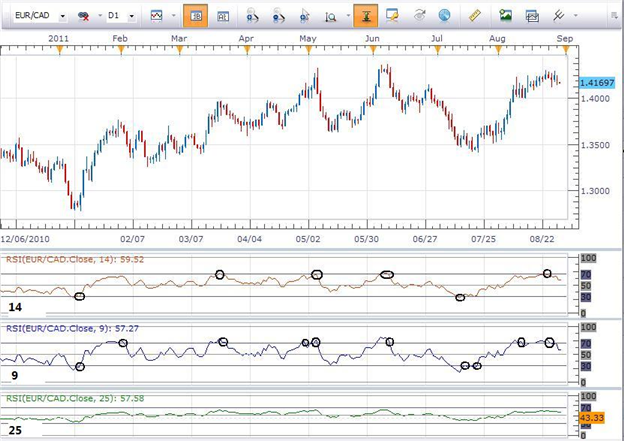When we focus on an indicator in our live Trading Room webinar sessions, the question often comes up regarding the number of periods to which the indicator should be set. Should one use the default setting or should a trader “tweak” the settings?
As a general rule, when the number of periods to which the indicator is set is increased, the indicator becomes less sensitive to price movement as it is using a larger number of periods to compute (average) its data. In effect, we are “slowing it down”. When the number of periods is decreased, the indicator becomes more sensitive to price movement since it is using fewer periods, a shorter span of time, to compute its data. In this case we are “speeding it up”.
Let’s use the RSI indicator on the Daily chart of the EURCAD below as our example…

(Just by way of a quick review, the RSI gives a buying signal when it has been below 30 and then closes above 30. The selling signal is provided from RSI when it has been above 70 and then closes below 70.)The first RSI on the chart below is the standard, default 14 period version. Based on the above criteria, a buying or selling signal was generated in each of the black circles for a total of 6 signals.On the second version below we have shortened the number of periods to 9. As can be seen, the indicator becomes much more sensitive and the difference in the number of signals generated is readily apparent. The total on this version is 10.
If one compares the signals themselves to the price action on the chart, we can see that some of the signals were valid and would have generated pips while others were simply a short lived blip on the chart…a false entry signal, if you will.The last version of the RSI is set at 25 periods. We can see the smoothing effect that increasing the number of periods has. Also, we note that not one signal is generated during the time frame encompassed by the chart. When a signal does appear, however, it will have greater level of reliability behind it than either the 9 or the 14 period.After all of the above is said, a trader can set the period to whatever they find best serves their trading style and strategy. This can be accomplished through experimentation with various time frames and logging the results.
For longer term trading the number might be increased. Fewer trading signals will be generated but they will have a greater level of reliability associated with them. (The same as using a longer term chart versus a shorter term chart for example.) Conversely, if you lessen the number of periods in the equation, more trading signals will be generated but they will have a lower level of reliability.
Written by Dailyfx.com

